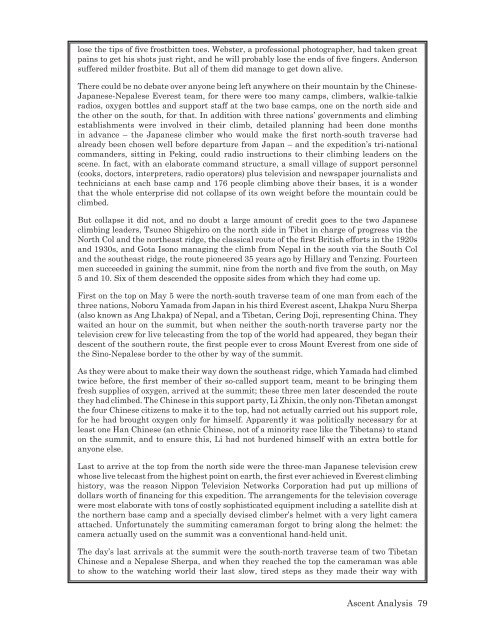The Himalaya by the Numbers: A Statistical Analysis - Himalayan ...
The Himalaya by the Numbers: A Statistical Analysis - Himalayan ...
The Himalaya by the Numbers: A Statistical Analysis - Himalayan ...
Create successful ePaper yourself
Turn your PDF publications into a flip-book with our unique Google optimized e-Paper software.
lose <strong>the</strong> tips of five frostbitten toes. Webster, a professional photographer, had taken great<br />
pains to get his shots just right, and he will probably lose <strong>the</strong> ends of five fingers. Anderson<br />
suffered milder frostbite. But all of <strong>the</strong>m did manage to get down alive.<br />
<strong>The</strong>re could be no debate over anyone being left anywhere on <strong>the</strong>ir mountain <strong>by</strong> <strong>the</strong> Chinese-<br />
Japanese-Nepalese Everest team, for <strong>the</strong>re were too many camps, climbers, walkie-talkie<br />
radios, oxygen bottles and support staff at <strong>the</strong> two base camps, one on <strong>the</strong> north side and<br />
<strong>the</strong> o<strong>the</strong>r on <strong>the</strong> south, for that. In addition with three nations’ governments and climbing<br />
establishments were involved in <strong>the</strong>ir climb, detailed planning had been done months<br />
in advance – <strong>the</strong> Japanese climber who would make <strong>the</strong> first north-south traverse had<br />
already been chosen well before departure from Japan – and <strong>the</strong> expedition’s tri-national<br />
commanders, sitting in Peking, could radio instructions to <strong>the</strong>ir climbing leaders on <strong>the</strong><br />
scene. In fact, with an elaborate command structure, a small village of support personnel<br />
(cooks, doctors, interpreters, radio operators) plus television and newspaper journalists and<br />
technicians at each base camp and 176 people climbing above <strong>the</strong>ir bases, it is a wonder<br />
that <strong>the</strong> whole enterprise did not collapse of its own weight before <strong>the</strong> mountain could be<br />
climbed.<br />
But collapse it did not, and no doubt a large amount of credit goes to <strong>the</strong> two Japanese<br />
climbing leaders, Tsuneo Shigehiro on <strong>the</strong> north side in Tibet in charge of progress via <strong>the</strong><br />
North Col and <strong>the</strong> nor<strong>the</strong>ast ridge, <strong>the</strong> classical route of <strong>the</strong> first British efforts in <strong>the</strong> 1920s<br />
and 1930s, and Gota Isono managing <strong>the</strong> climb from Nepal in <strong>the</strong> south via <strong>the</strong> South Col<br />
and <strong>the</strong> sou<strong>the</strong>ast ridge, <strong>the</strong> route pioneered 35 years ago <strong>by</strong> Hillary and Tenzing. Fourteen<br />
men succeeded in gaining <strong>the</strong> summit, nine from <strong>the</strong> north and five from <strong>the</strong> south, on May<br />
5 and 10. Six of <strong>the</strong>m descended <strong>the</strong> opposite sides from which <strong>the</strong>y had come up.<br />
First on <strong>the</strong> top on May 5 were <strong>the</strong> north-south traverse team of one man from each of <strong>the</strong><br />
three nations, Noboru Yamada from Japan in his third Everest ascent, Lhakpa Nuru Sherpa<br />
(also known as Ang Lhakpa) of Nepal, and a Tibetan, Cering Doji, representing China. <strong>The</strong>y<br />
waited an hour on <strong>the</strong> summit, but when nei<strong>the</strong>r <strong>the</strong> south-north traverse party nor <strong>the</strong><br />
television crew for live telecasting from <strong>the</strong> top of <strong>the</strong> world had appeared, <strong>the</strong>y began <strong>the</strong>ir<br />
descent of <strong>the</strong> sou<strong>the</strong>rn route, <strong>the</strong> first people ever to cross Mount Everest from one side of<br />
<strong>the</strong> Sino-Nepalese border to <strong>the</strong> o<strong>the</strong>r <strong>by</strong> way of <strong>the</strong> summit.<br />
As <strong>the</strong>y were about to make <strong>the</strong>ir way down <strong>the</strong> sou<strong>the</strong>ast ridge, which Yamada had climbed<br />
twice before, <strong>the</strong> first member of <strong>the</strong>ir so-called support team, meant to be bringing <strong>the</strong>m<br />
fresh supplies of oxygen, arrived at <strong>the</strong> summit; <strong>the</strong>se three men later descended <strong>the</strong> route<br />
<strong>the</strong>y had climbed. <strong>The</strong> Chinese in this support party, Li Zhixin, <strong>the</strong> only non-Tibetan amongst<br />
<strong>the</strong> four Chinese citizens to make it to <strong>the</strong> top, had not actually carried out his support role,<br />
for he had brought oxygen only for himself. Apparently it was politically necessary for at<br />
least one Han Chinese (an ethnic Chinese, not of a minority race like <strong>the</strong> Tibetans) to stand<br />
on <strong>the</strong> summit, and to ensure this, Li had not burdened himself with an extra bottle for<br />
anyone else.<br />
Last to arrive at <strong>the</strong> top from <strong>the</strong> north side were <strong>the</strong> three-man Japanese television crew<br />
whose live telecast from <strong>the</strong> highest point on earth, <strong>the</strong> first ever achieved in Everest climbing<br />
history, was <strong>the</strong> reason Nippon Television Networks Corporation had put up millions of<br />
dollars worth of financing for this expedition. <strong>The</strong> arrangements for <strong>the</strong> television coverage<br />
were most elaborate with tons of costly sophisticated equipment including a satellite dish at<br />
<strong>the</strong> nor<strong>the</strong>rn base camp and a specially devised climber’s helmet with a very light camera<br />
attached. Unfortunately <strong>the</strong> summiting cameraman forgot to bring along <strong>the</strong> helmet: <strong>the</strong><br />
camera actually used on <strong>the</strong> summit was a conventional hand-held unit.<br />
<strong>The</strong> day’s last arrivals at <strong>the</strong> summit were <strong>the</strong> south-north traverse team of two Tibetan<br />
Chinese and a Nepalese Sherpa, and when <strong>the</strong>y reached <strong>the</strong> top <strong>the</strong> cameraman was able<br />
to show to <strong>the</strong> watching world <strong>the</strong>ir last slow, tired steps as <strong>the</strong>y made <strong>the</strong>ir way with<br />
Ascent <strong>Analysis</strong> 79


